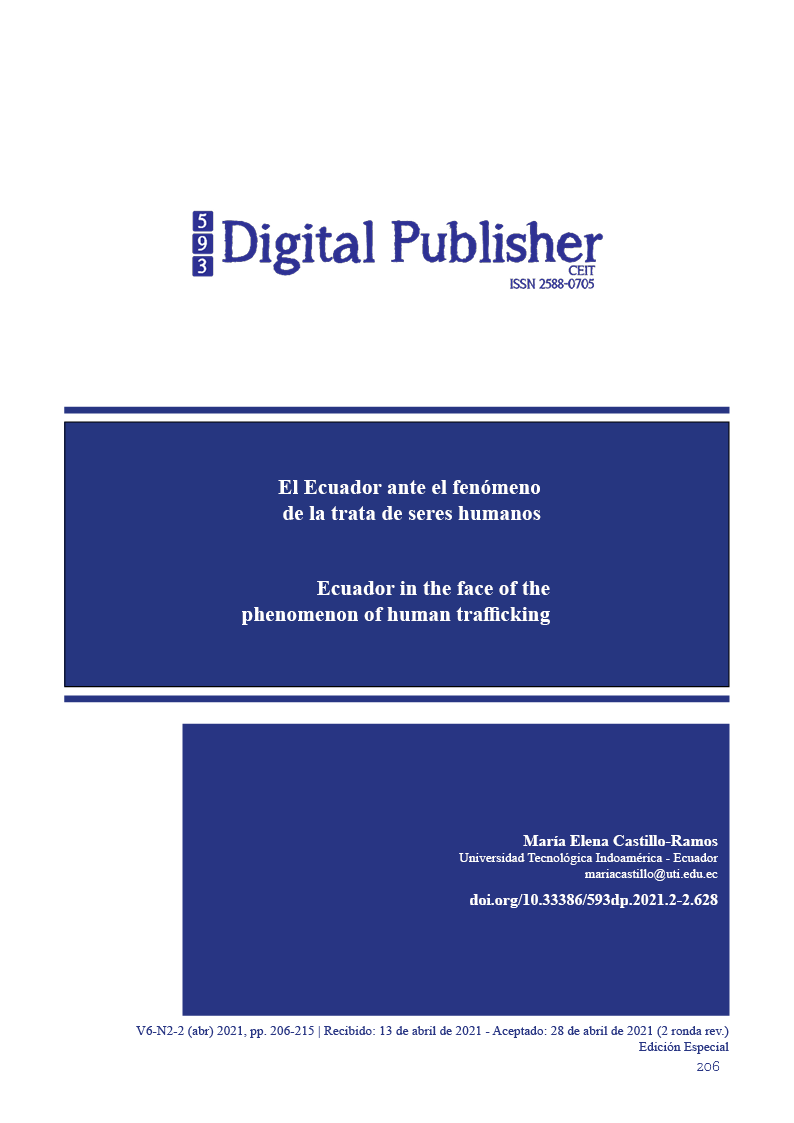El Ecuador in the face of the phenomenon of human trafficking
Main Article Content
Abstract
Trafficking in human beings constitutes a form of modern slavery, currently it has been called the slavery of the 21st century as it is considered a crime against humanity, at the same time as a serious violation of human rights. It is considered that no country is immune to trafficking and in view of this scenario, it becomes necessary to join efforts aimed at preventing and fighting to effectively confront this phenomenon.
The Palermo Protocol is the worldwide reference standard that defines the crime of trafficking in human beings, describing the various modalities under which it can be presented, where special emphasis is placed on the protection of victims, in addition to inciting states part to criminalize human trafficking in a comprehensive manner. In this sense, one of the most important achievements of the Protocol is the harmonization of the internal regulations of the states to drastically confront this crime, by virtue of which all exploitation of human beings must be punished with the rigor of the law.
In this regard, our country has aligned its internal regulations with the provisions of the Palermo Protocol. In the first instance, the Ecuadorian Constitution prohibits all types of slavery and specifically human trafficking. Trafficking has been classified as a crime against humanity, including all forms of exploitation of human beings. What is exploitation and who are the victims of trafficking has been defined, and in the same way, several application principles have been established in the matter focused on the identification and care of the victims. Among them, the non-detention and non-criminalization of trafficking victims stand out. Another important effort has been to appoint a governing body on trafficking, which is the Ministry of Government, which has led the construction of the Plan of Action Against Trafficking in Persons in Ecuador 2019-2030.
On the other hand, the numbers of victims of this crime grow every year without being a reflection of what really happens in society regarding trafficking and this is a reality not only at the national level but also at the global level, where it is common to evidence that various exploitation practices are naturalized. Also contributing to this underreporting of victims is the fear of being denounced and / or deported, the fear of reprisals from their traffickers and in many cases not being able to identify themselves as victims of trafficking.
Downloads
Article Details

This work is licensed under a Creative Commons Attribution-NonCommercial-ShareAlike 4.0 International License.
1. Derechos de autor
Las obras que se publican en 593 Digital Publisher CEIT están sujetas a los siguientes términos:
1.1. 593 Digital Publisher CEIT, conserva los derechos patrimoniales (copyright) de las obras publicadas, favorece y permite la reutilización de las mismas bajo la licencia Licencia Creative Commons 4.0 de Reconocimiento-NoComercial-CompartirIgual 4.0, por lo cual se pueden copiar, usar, difundir, transmitir y exponer públicamente, siempre que:
1.1.a. Se cite la autoría y fuente original de su publicación (revista, editorial, URL).
1.1.b. No se usen para fines comerciales u onerosos.
1.1.c. Se mencione la existencia y especificaciones de esta licencia de uso.
References
Código Orgánico Integral Penal, (2014). https://www.defensa.gob.ec
Ley orgánica de Movilidad Humana, (2017). https://www.acnur.org
Convenio de Varsovia de 1929: Qué es y qué regula. (2019, agosto 20). Conceptos Jurídicos. https://www.conceptosjuridicos.com/convenio-de-varsovia/
Cordero Ramos, N., & Cruz Zúñiga, P. (2019). Trata de personas, género y migraciones en Andalucía (España), Costa Rica y Marruecos: Retos y propuestas para la defensa y garantía de los derechos humanos. http://vlex.com/account/login_ip?fuente_id=30626
Gallegos, J. M. F. (2018). PALABRAS CLAVES: TRATA DE PERSONAS, TRANSNACIONALES, MAFIAS, CLANDESTINOS, COERCIÓN, DISFUNCIONALES, VULNERABILIDAD, VICTIMA, VICTIMARIO, AMENAZA, CONSENTIMIENTO.
Mexico, & International Organization for Migration (Eds.). (2009). Manual para la prevención de la trata de personas (1. ed). Comisión Nacional de los Derechos Humanos, México: OIM.
Ministerio de Gobierno. (2019). PLAN DE ACCIÓN CONTRA LA TRATA DE PERSONAS EN ECUADOR 2019—2030. https://www.ministeriodegobierno.gob.ec/
Miradas críticas sobre la trata de seres humanos: Diálogos académicos en construcción (Primera). (2015). Universidad de Los Andes, Facultad de Ciencias Sociales, Departamento de Ciencia Política, Ediciones Uniandes.
Protocolo de Palermo, (2003). https://www.mininterior.gov.co
Staff, M. (2009). Recorrido histórico sobre la trata de personas. UASB Temas de análisis, 160-167.
Villacampa, C., & Torres, N. (2012). MUJERES VÍCTIMAS DE TRATA EN PRISIÓN EN ESPAÑA. 84.


